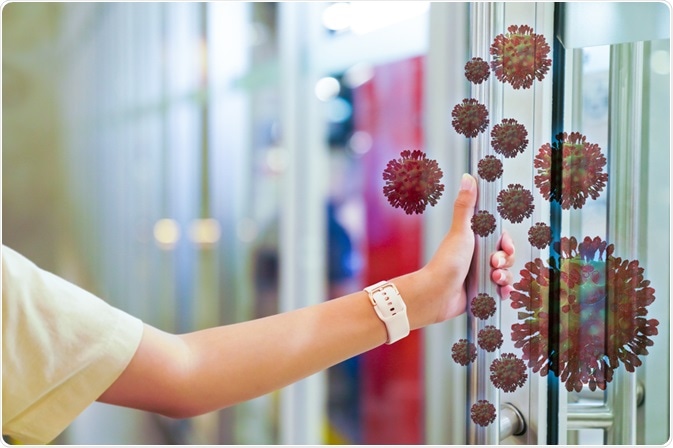COVID-19 is an infectious disease caused by the severe acute respiratory syndrome coronavirus 2 (SARS-CoV-2). It is primarily spread person to person by small droplets, or by contact with contaminated surfaces. Maintaining social distancing and maximizing personal hygiene levels reduces the risk of transmitting the virus, as well as reducing your risk of getting infected.
.jpg) Image Credit: GEMINI PRO STUDIO/Shutterstock.com
Image Credit: GEMINI PRO STUDIO/Shutterstock.com
What is COVID-19?
Coronavirus Disease 2019, or COVID-19, is an infectious acute respiratory disease caused by the severe acute respiratory syndrome coronavirus 2 (SARS-CoV-2). Initially identified in Wuhan, China, COVID-19 rapidly became a global pandemic as of 30th January 2020 and is still ongoing as of February 2021. Worldwide, around 113 million cases of COVID-19 have been confirmed with around 2.5 million deaths (as of February 25, 2021).
Symptoms of COVID-19 vary person to person but typically include flu-like symptoms and appear 2-14 days after infection (see here for COVID-19 symptoms). An infected person is usually contagious for up to 14 days and based on this, affected individuals must self-isolate for around 2 weeks (depending on country guidelines) until symptoms disappear.
For a minority of patients, usually the over 70s and those with pre-existing health conditions, the symptoms may worsen and require hospitalization.
Affected people are at their most infectious (contagious) early on, within the first five days of showing symptoms according to a study published in The Lancet in November 2020. There is dispute as to how long an infected person stays contagious, but CDC guidelines suggest individuals can be contagious up to 10 days after the first appearance of symptoms (there are reports of longer infectious periods).
Some affected individuals may be completely asymptomatic and can still be contagious, a feature that helped to facilitate the rapid spread of the virus.
How is COVID-19 spread?
As COVID-19 belongs to the coronavirus family – closely related to the Severe Acute Respiratory Syndrome (SARS) & Middle East Respiratory Syndrome Coronavirus (MERS) virus – the primary route of transmission is the inhalation of small respiratory droplets from an infected person.
These small droplets produced from an infected person (symptomatic or asymptomatic) usually arise from sneezing, coughing, and even talking. Thus, those within proximity of less than 1 meter from an infected person are at a high risk of inhaling viral particles from an infected person.
Larger respiratory droplets (talking and coughing mildly) only remain in the air for a short period and typically do not travel distances greater than 1 meter. However, smaller respiratory ‘nuclei’ from sneezing (aerosolized) can travel distances greater than 1m.
The current evidence suggests that in most cases COVID-19 is transmitted by respiratory droplets, though symptomatic individuals that sneeze (less common in COVID-19 than flu) can propel particles much further. Thus, the risk of infection inside enclosed spaces is far greater than being outside.
Other indirect routes of transmission may include coming into contact with contaminated surfaces (called fomites) as a result of contagious droplets falling on these surfaces. When someone touches an infected surface and then touches their face (close proximity to mouth, nose, and eyes), the risk of the virus entering the body is significantly increased.
Coronaviruses, in general, have poor survivability on surfaces thus the risk of getting infected by touching parcels or shopping items is relatively low (the virus can only survive up to 1 day on cardboard and up to 2 days on plastic).
Amidst the pandemic, it is advisable to wipe surfaces and packets with a detergent disinfectant or alcohol wipes. Many shops and supermarkets now employ hygiene measures such as hand sanitizers and disinfectants before entrance. It is important for restaurants and takeaways to enhance hygiene efforts in order to make food in these contexts safe.
Lastly, some evidence has suggested the presence of SARS-CoV-2 RNA in stool samples from infected people – though whether these are infectious virus particles is still to be seen. Some evidence does point to infectious viral particles being present after flushing the toilet and keeping the toilet lid down reduced this supposed spread.
It is also safe to assume, based on all the emerging evidence, that all bodily secretions except for sweat may contain infectious virus particles. However, none of these routes are thought to be the main infection route for SARS-CoV-2, although caution is advised.
 Image Credit: frank60 / Shutterstock.com
Image Credit: frank60 / Shutterstock.com
Preventing COVID-19 spread
In line with World Health Organization (WHO) guidelines, and national guidelines (e.g. CDC for the US, NHS for the UK), all those with symptoms of COVID-19 (or any new ‘flu’-like symptoms) should immediately self-isolate (or quarantine) for 10 days after symptoms develop.
During this time, infected (or suspected) individuals must not leave the house, except for essential purposes. Shopping should be done by a family or friend on their behalf, if possible. Wherever an infected person has to leave their house, they must remain socially distant and wear a face covering at all times.
The CDC recommends a 6 feet social distancing rule in all settings (apart from those within the same household, or those forming exclusive social bubbles).
The evidence for using face masks or coverings was initially ambiguous, however, evidence has strongly pointed to the use of face coverings in public places to prevent spread. Many countries now legally require people to wear face coverings in public places, including transport, shops and supermarkets.
Wearing a face covering greatly reduces the risk of transmitting the virus. However, children under 2 years or those with conditions such as severe asthma should not wear a face covering and can obtain official exemptions in some countries.
Washing one’s hands for 20 seconds with hot water and soap is an effective way to eliminate virus particles on one’s hands and should be performed more regularly than usual. Washing should be carried out especially after returning home from somewhere, for example after shopping or working in an office or retail environment with shared facilities.
Hand sanitizers with a minimum of 60% alcohol content are also effective and should be used when washing is not possible. However, hand sanitizers are not as affective as thorough hand washing and so washing should be the choice where possible. Furthermore, people should avoid touching their face with unwashed hands.
Preventative strategies such as the ones discussed above, in addition to government policies and adherence to such strategies, are crucial in preventing the spread of the disease and reducing the R number to prevent the growth of the pandemic.
 Image Credit: eamesBot / Shutterstock.com
Image Credit: eamesBot / Shutterstock.com
References
- CDC.gov, 2020. Coronavirus Disease 2019. https://www.cdc.gov/coronavirus/2019-ncov/faq.html#How-COVID-19-Spreads
- Gov.uk, 2020. Coronavirus (COVID-19) https://www.gov.uk/government/publications/wuhan-novel-coronavirus-infection-prevention-and-control/transmission-characteristics-and-principles-of-infection-prevention-and-control
- Galbadage et al, 2020. Does COVID-19 Spread Through Droplets Alone? Front Public Health. 8:163 https://www.ncbi.nlm.nih.gov/pmc/articles/PMC7193306/
- M. Cevik et al., 2020. SARS-CoV-2, SARS-CoV, and MERS-CoV viral load dynamics, duration of viral shedding, and infectiousness: a systematic review and meta-analysis,” The Lancet Microbe, 2(1):E13-E22. https://www.thelancet.com/journals/lanmic/article/PIIS2666-5247(20)30172-5/fulltext
- Ningthoujam, 2020. COVID 19 can spread through breathing, talking, study estimates. Curr Med Res Pract. 10(3): 132–133. https://www.ncbi.nlm.nih.gov/pmc/articles/PMC7205645/
- Singhal, 2020. A Review of Coronavirus Disease-2019 (COVID-19). Indian J Pediatr. 87(4): 281–286. https://www.ncbi.nlm.nih.gov/pmc/articles/PMC7090728/
Further Reading
Last Updated: Feb 25, 2021